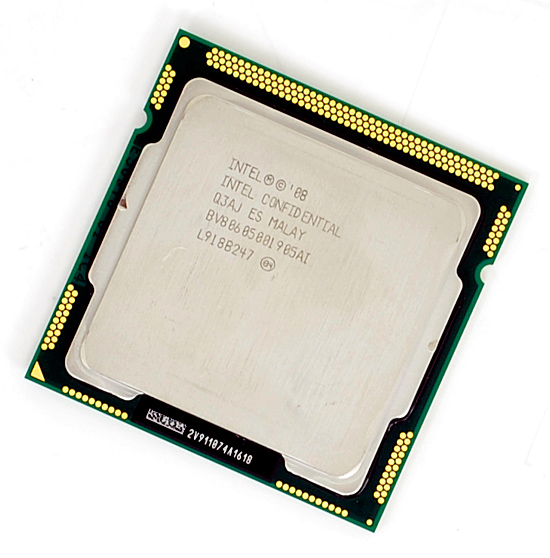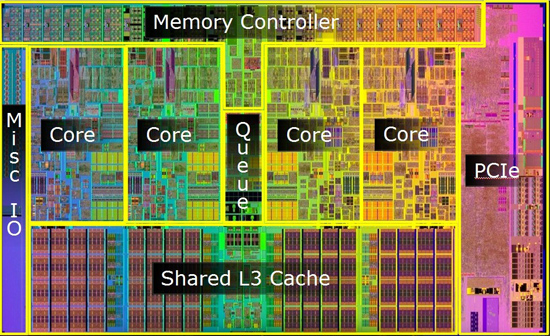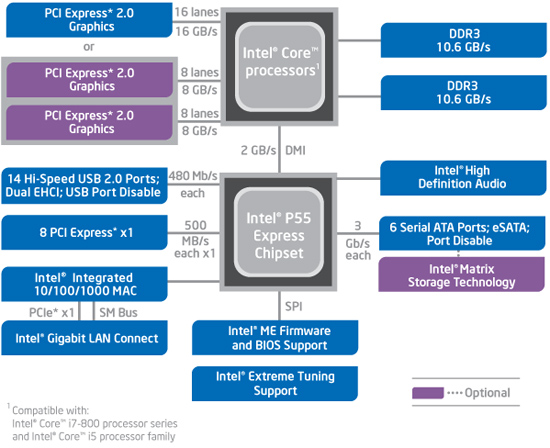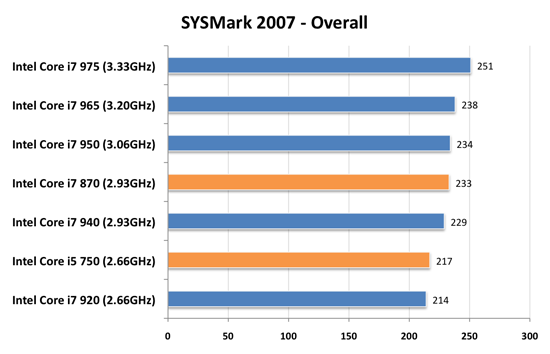Intel's Core i7 870 & i5 750, Lynnfield: Harder, Better, Faster Stronger
by Anand Lal Shimpi on September 8, 2009 12:00 AM EST- Posted in
- CPUs
Intel is on the verge of transitioning to 32nm. We'll see the first parts this year. What do you do with your 45nm fabs when you start moving volume away from them? Make really cheap quad-core Nehalems of course:

I'm talking $196. I'm talking faster than AMD's entire lineup. I'm talking about arguably the best processor of 2009. I'm talking about Lynnfield, and here's its backside:

Mmm
I spent much of the past year harping on AMD selling Nehalem-sized Phenom IIs for less than Intel sold Nehalems. With Lynnfield, Intel actually made Nehalem even bigger all while driving prices down. Like I said, what do you do when you're still making boatloads of money in a recession and are about to start emptying your 45nm fabs?
I should clear things up before we progress much further. Lynnfield is the codename for mainstream 45nm quad-core Nehalem, while Bloomfield refers to the first Nehalem launched at the end of 2008:
| Processor | Manufacturing Process | Die Size | Transistor Count | Socket |
| Bloomfield | 45nm | 263 mm2 | 731M | LGA-1366 |
| Lynnfield | 45nm | 296 mm2 | 774M | LGA-1156 |
Despite being cheaper, Lynnfield is larger than Bloomfield. The larger die is due to one major addition: an on-die PCIe controller.

Bloomfield, The First Nehalem, circa 2008

Lynnfield, Nehalem for All, circa 2009
The pink block to the right of the die is the PCIe controller, that's 16 PCIe 2.0 lanes coming right off the chip. Say hello to ultra low latency GPU communication. You'd think that Intel was about to enter the graphics market or something with a design like this.
Sacrifices were made to reduce CPU, socket and board complexity. Gone are the two QPI links that each provided 25.6GB/s of bandwidth to other CPUs or chips on the motherboard. We also lose one of the three 64-bit DDR3 memory channels, Lynnfield only has two like a normal processor (silly overachieving Bloomfield).

Intel's Bloomfield Platform (X58 + LGA-1366)
The sum is that Lynnfield is exclusively single-socket; there will be no LGA-1156 Skulltrail. While the dual-channel memory controller isn't really a limitation for quad-core parts, six and eight core designs may be better suited for LGA-1366.

Intel's Lynnfield Platform (P55 + LGA-1156)
The loss of QPI means that Lynnfield doesn't have a super fast connection to the rest of the system, but with an on-die PCIe controller it doesn't matter: the GPU is fed right off the CPU.
The Lineup
We get three Lynnfield CPUs today: the Core i7 870, Core i7 860 and the Core i5 750. Intel's branding folks told us that the naming would make sense one we saw the rest of the "Core" parts introduced; yeah that was pretty much a lie. At least there aren't any overlapping part numbers (e.g. Core i5 860 and Core i7 860).
The i7 in this case denotes four cores + Hyper Threading, the i5 means four cores but no Hyper Threading. The rules get more complicated as you bring notebooks into the fray but let's momentarily bask in marginal simplicity.
| Processor | Clock Speed | Cores / Threads | Maximum Single Core Turbo Frequency | TDP | Price |
| Intel Core i7-975 Extreme | 3.33GHz | 4 / 8 | 3.60GHz | 130W | $999 |
| Intel Core i7 965 Extreme | 3.20GHz | 4 / 8 | 3.46GHz | 130W | $999 |
| Intel Core i7 940 | 2.93GHz | 4 / 8 | 3.20GHz | 130W | $562 |
| Intel Core i7 920 | 2.66GHz | 4 / 8 | 2.93GHz | 130W | $284 |
| Intel Core i7 870 | 2.93GHz | 4 / 8 | 3.60GHz | 95W | $562 |
| Intel Core i7 860 | 2.80GHz | 4 / 8 | 3.46GHz | 95W | $284 |
| Intel Core i5 750 | 2.66GHz | 4 / 4 | 3.20GHz | 95W | $196 |
Keeping Hyper Threading off of the Core i5 is purely done to limit performance. There aren't any yield reasons why HT couldn't be enabled.
Intel was very careful with both pricing and performance of its Lynnfield processors. I'm going to go ahead and say it right now, there's no need for any LGA-1366 processors slower than a Core i7 965:

This is only one benchmark, but it's representative of what you're about to see. The Core i7 870 (LGA-1156) is as fast, if not faster, than every single LGA-1366 processor except for the ones that cost $999. Its pricing is competitive as well:

For $196 you're getting a processor that's faster than the Core i7 920. I'm not taking into account motherboard prices either, which are anywhere from $50 - $100 cheaper for LGA-1156 boards. I don't believe LGA-1366 is dead, but there's absolutely no reason to buy anything slower than a 965 if you're going that route.










343 Comments
View All Comments
Seramics - Wednesday, September 9, 2009 - link
So what's the big deal here? I dun tink its that impressive, just good. While S196 of 750 look to outcompete the "way" more expensive $245 of AMD's 965, the truth is that the mobo that you need to pair the 750/860/870 is far from being competitive. P55 is severely stripped down and it is only slightly cheaper than their X58 counterpart. So wht if 750 is cheaper than 965 by about %50? Did you just buy the cpu only? Ppl shud at least look at the CPU+mobo price because they both come together. Truth is, when you take into account mobo price, 750 is far from outcompete 965. Added up, I think its only about balanced. The 750 is a better CPU, but it also cost more. In comparison to their socket 1366 partner, socket 1156 system cost a little less, but they are also inferior a little bit. So what's special them? Sure, there are better turbo and better thermal performance. For me, that is all that is good about the 1156 CPU. For enthusiast, socket 1366 is the way to go.jnr0077 - Friday, July 27, 2012 - link
i have a i5 750 chip cost £100 a gigabyte GA-P55A-UD6 cost £100 as it has six ram slots 16gb max radeon hd 4850 i love this mobo i cant fault it for the price i find it is a brilliant upgrade for cost i spent £250 considering the price of shops build you own pc you get what you put in :) very happy with the i5 750 1156 socket windows score on basic 500gb 7200 is 5.9 sweet 7.9 with a ssd :) can anyone tell me what the amd 965 hit on base score as i will never DV8 to amd intel 4 me allways :)hob196 - Wednesday, September 9, 2009 - link
Hi,Thanks for another great article.
I figure that having PCI-e on chip would be great to reduce the latency. Any thoughts about plugging non graphics PCI-e cards into the second PCI-e slot?
I've heard some motherboards cripple the 2nd slots performance down to x1 if you plug an x1 card in the other slot (in a shared x8 environment)any evidence of this?
In case you're curious I work with digital audio in a studio environment and I'm always striving to reduce the latency of audio going through the CPU.
These days, the latency (in streaming audio) is down to how fast the CPU can push floating point plus any overhead for the buffers in the various busses you go through. e.g. A firewire sound interface adds a few ms because of the inherent buffers between CPU -> Northbridge -> Southbridge -> Firewire -> Interface.
tempestor - Wednesday, September 9, 2009 - link
Another great article Anand!You should consider a 2nd job as a novel writer! :D
lp, M.
AndyKH - Wednesday, September 9, 2009 - link
I don't really get it:It is stated that most PCIe cards don't work well with higher frequencies and that the BCLK frequency should be kept at multiples of 133 MHz, and then they overclock it using a BCLK of ~200 MHz in one instance???
Doesn't the 133 MHz requirement make it pretty much impossible to overclock?
Someone please enlighten me.
Anand Lal Shimpi - Wednesday, September 9, 2009 - link
It doesn't make it impossible to overclock, just impossible to overclock (very high) without additional voltage.Take care,
Anand
AndyKH - Thursday, September 10, 2009 - link
Thank you for the response!I see how using a higher voltage will increase switching speed of the buffers driving the PCIe bus. However, I fail to see why it would make it any less dificult for PCIe cards to cope with the increased clock frequency, unless the increased voltage is also fed to the PCIe cards (is this the case?). Otherwise I assume they would surely experience the same problems driving communication to the CPU?
Also, you write multiples of 133 MHz but overclock to 200 MHz BCLK. Shouldn't it read multiples of 33 MHz?
TotalLamer - Wednesday, September 9, 2009 - link
I really, really don't understand why Anand is so obsessed with Turbo Modes. Any enthusiast who dares call himself such is going to clock this chip to the moon, at which point Turbo doesn't do anything. So with a 4.2GHz i7 870, all you're really left with is an i7 920 with worse multi-GPU gaming performance and and a less-certain upgrade path.coconutboy - Wednesday, September 9, 2009 - link
You're assuming all enthusiasts think like you do, but the heavy majority of people (enthusiast or not) want nothing to do with a $500+ i7 870 cpu. The i7 920, 860, and i5 920 are much more attractive options.There are plenty of "enthusiasts" who instead prefer silent computers that use no fans, or people living in hot climates who focus on very low temps, or all manner of different things. On top of that, the overwhelming majority of people simply do not care about any of the aforementioned, and those people buy the heavy majority of computers.
I started OCing in 1996, and used to OC pretty heavily, but got tired of constant tweaking or seeing my well-worn parts die prematurely. Now I tend to focus on very quiet computers that have a small/moderate overclock. So taking an i5 750 or i7 860 and raising it up 200-400 MHz and leaving turbo on is very appealing to me. Also of note is the extra heat generated and the extra money I'll spend on my electric bill by having a 24/7 overclock versus turbo modes. Dig the link and scroll to the bottom-
http://www.guru3d.com/article/core-i5-750-core-i7-...">http://www.guru3d.com/article/core-i5-750-core-i7-...
review-test/10
The 13 watt increase at idle is no big deal, but 133 extra watts under load, well... it's worth the performance boost and heat to some folks, but other people (like me) look at those things as tradeoffs that need to be weighed versus reliability, cost for extra cooling, noise, my electric bill etc.
Skiprudder - Thursday, September 10, 2009 - link
I think that some of us are quite honestly getting more green conscious these days too. It's nice to have a CPU this fast that's also this energy efficient. We can get similar to OCed performance at a much smaller power envelope. I know it doesn't add up to a lot over the course of a year (less than $100 I assume), but these things add up and it saves me some dinero on the power bills!